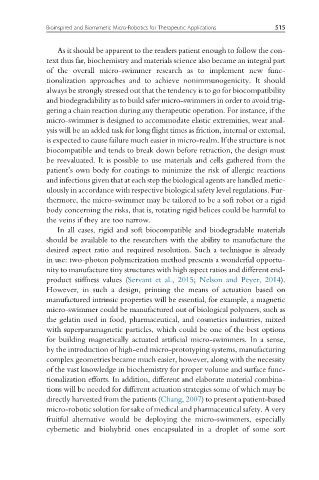Page 522 - Handbook of Biomechatronics
P. 522
Bioinspired and Biomimetic Micro-Robotics for Therapeutic Applications 515
As it should be apparent to the readers patient enough to follow the con-
text thus far, biochemistry and materials science also became an integral part
of the overall micro-swimmer research as to implement new func-
tionalization approaches and to achieve nonimmunogenicity. It should
always be strongly stressed out that the tendency is to go for biocompatibility
and biodegradability as to build safer micro-swimmers in order to avoid trig-
gering a chain reaction during any therapeutic operation. For instance, if the
micro-swimmer is designed to accommodate elastic extremities, wear anal-
ysis will be an added task for long flight times as friction, internal or external,
is expected to cause failure much easier in micro-realm. If the structure is not
biocompatible and tends to break down before retraction, the design must
be reevaluated. It is possible to use materials and cells gathered from the
patient’s own body for coatings to minimize the risk of allergic reactions
and infections given that at each step the biological agents are handled metic-
ulously in accordance with respective biological safety level regulations. Fur-
thermore, the micro-swimmer may be tailored to be a soft robot or a rigid
body concerning the risks, that is, rotating rigid helices could be harmful to
the veins if they are too narrow.
In all cases, rigid and soft biocompatible and biodegradable materials
should be available to the researchers with the ability to manufacture the
desired aspect ratio and required resolution. Such a technique is already
in use: two-photon polymerization method presents a wonderful opportu-
nity to manufacture tiny structures with high aspect ratios and different end-
product stiffness values (Servant et al., 2015; Nelson and Peyer, 2014).
However, in such a design, printing the means of actuation based on
manufactured intrinsic properties will be essential, for example, a magnetic
micro-swimmer could be manufactured out of biological polymers, such as
the gelatin used in food, pharmaceutical, and cosmetics industries, mixed
with superparamagnetic particles, which could be one of the best options
for building magnetically actuated artificial micro-swimmers. In a sense,
by the introduction of high-end micro-prototyping systems, manufacturing
complex geometries became much easier, however, along with the necessity
of the vast knowledge in biochemistry for proper volume and surface func-
tionalization efforts. In addition, different and elaborate material combina-
tions will be needed for different actuation strategies some of which may be
directly harvested from the patients (Chang, 2007) to present a patient-based
micro-robotic solution for sake of medical and pharmaceutical safety. A very
fruitful alternative would be deploying the micro-swimmers, especially
cybernetic and biohybrid ones encapsulated in a droplet of some sort

